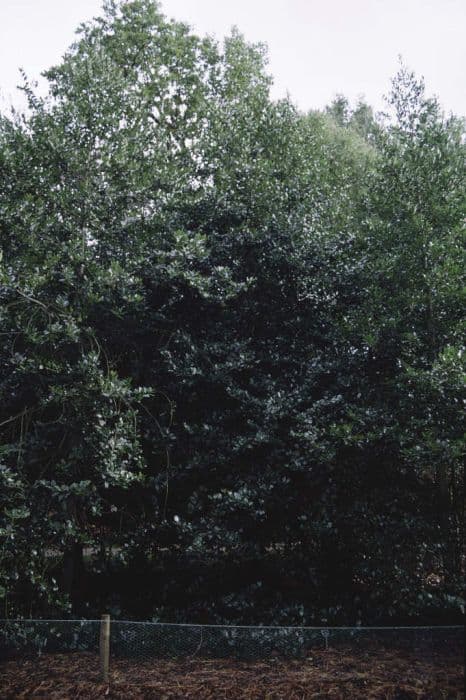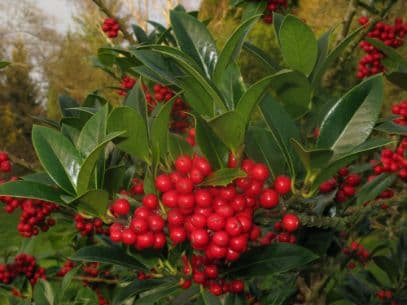Highclere Holly Ilex × altaclerensis 'Ripley Gold' (f/v)

ABOUT
The plant commonly known as 'Ripley Gold' Holly is notable for its appearance, which includes distinctive foliage and an overall impression of vitality and beauty. The leaves are a striking feature; they are variegated, meaning they have a mix of colors. The central part of the leaf is a vibrant green while the edges are trimmed in a creamy yellow to gold color, lending an appearance that is both bright and elegant. The 'Ripley Gold' Holly is an evergreen, ensuring that its glossy, colorful leaves are showcased year-round. The leaves are also characterized by their shape, which is slightly wavy and possesses spiny edges, typical of many holly varieties. This toothed edge gives the leaves texture and character, making the plant a visually appealing addition to any garden. In addition to its foliage, the 'Ripley Gold' Holly may produce small flowers; however, they are not particularly showy when compared to the eye-catching nature of the leaves. If conditions permit, the plant could also bear fruit. The berries are traditionally associated with holly plants, however, 'Ripley Gold' Holly's most celebrated feature remains its uniquely patterned leaves.
About this plant
 Names
NamesSynonyms
Highclere Holly, Ripley Gold Holly
Common names
Ilex × altaclerensis 'Ripley Gold'
 Toxicity
ToxicityTo humans
The Highclere holly is considered to be toxic to humans. If ingested, the plant can cause symptoms such as vomiting, diarrhea, and abdominal pain. The berries of the holly are especially toxic, and consumption of a large quantity can result in severe gastroenteritis. Additionally, there is a risk of drowsiness, dehydration, and electrolyte imbalance from persistent vomiting and diarrhea if a large amount of the plant is consumed.
To pets
The Highclere holly is also toxic to pets, including both cats and dogs. If a pet ingests the leaves or berries of the plant, they may exhibit signs of poisoning, which can include vomiting, diarrhea, drooling, and a lack of appetite. In severe cases, ingestion can lead to lethargy, dehydration, and possibly more serious gastrointestinal upset. It is important for pet owners to prevent their pets from eating any part of the plant and to seek veterinary care if they suspect their pet has ingested it.
 Characteristics
CharacteristicsLife cycle
Perennials
Foliage type
Evergreen
Color of leaves
Variegated
Flower color
White
Height
8 feet 2.44 meters
Spread
8 feet 2.44 meters
Plant type
Shrub
Hardiness zones
6
Native area
Cultivar
Benefits
 General Benefits
General Benefits- Ornamental Appeal: The 'Ripley Gold' variegated holly adds visual interest to landscapes with its distinctive green and gold variegated leaves.
- Low Maintenance: This plant requires minimal care once established, making it suitable for gardeners of all skill levels.
- Drought Tolerance: It is relatively drought-tolerant, reducing the need for frequent watering during dry periods.
- Wildlife Habitat: Provides shelter and berries for birds and other wildlife, supporting biodiversity in the garden.
- Screening and Privacy: Can be used as a hedge or screen to provide privacy and block out unwanted views or noise.
- Seasonal Interest: With its evergreen foliage, it offers year-round color and structure in the garden.
- Tolerance of Conditions: Adapts well to a range of soil types and can handle urban pollution, making it versatile in different environments.
- Suitable for Topiary: Ideal for shaping into topiary forms, offering creative options for garden design.
 Medical Properties
Medical PropertiesThis plant is not used for medical purposes.
 Air-purifying Qualities
Air-purifying QualitiesThis plant is not specifically known for air purifying qualities.
 Other Uses
Other Uses- Photography backdrop: The variegated leaves of Ilex 'Ripley Gold' can provide a visually interesting background for close-up photography or macro shots.
- Edible garnish: While it is not commonly known for being edible, the young leaves can potentially be used as a decorative garnish after proper confirmation of safety.
- Artistic inspiration: Artists may use the plant's striking foliage as inspiration in paintings, drawings, or textile designs.
- Crafting material: Dried branches of Ilex 'Ripley Gold' can be used in floral arrangements or as part of handcrafted wreaths.
- Natural dye: The leaves and bark, with the proper processing, might be used as a source of natural dyes for fabric or other materials.
- Education: The plant can be used in horticultural education to teach about hybridization and cultivar development.
- Erosion control: Due to its dense growing habit, it may be effective for soil stabilization in certain landscape settings.
- Sound barrier: Planted in masses, the dense foliage can help reduce noise pollution in urban areas.
- Festive decoration: Its evergreen foliage and golden variegation can be incorporated into festive wreaths or arrangements during the holiday season.
- Culinary experimentation: Experimenting chefs might explore the flavor profile of non-toxic parts for avant-garde dishes.
Interesting Facts
 Feng Shui
Feng ShuiThe Highclere Holly is not used in Feng Shui practice.
 Zodiac Sign Compitability
Zodiac Sign CompitabilityThe Highclere Holly is not used in astrology practice.
 Plant Symbolism
Plant Symbolism- Endurance and Resilience: Ilex, commonly known as holly, is often associated with durability due to its robust nature and evergreen leaves, symbolizing the ability to endure difficult conditions.
- Protection: Holly plants have prickly leaves, which historically were believed to fend off evil spirits and negative energies, hence representing protection and defense against harm.
- Hope: The evergreen quality of holly symbolizes eternal life and hope through hardships, as it remains vibrant even in the harshest winters.
- Good Fortune: In some cultures, holly is considered a plant that brings good luck, especially when kept indoors during the winter season.
- Festivity and Celebration: Due to its association with Christmas, holly represents joy, festivity, and the spirit of celebration connected to this holiday time.
 Water
WaterThe Highclere holly should be watered deeply and thoroughly, ensuring the soil is moist but not waterlogged. During the growing season, water the plant once a week with about 1 to 1.5 gallons of water per session. In the hot summer months, check the soil moisture frequently and water more often if necessary, especially if there are extended periods of drought. Reduce watering in the fall and water sparingly in the winter, as the plant requires less moisture during dormancy.
 Light
LightHighclere holly thrives best in full sun to partial shade. It should be placed in a location where it can receive at least four to six hours of direct sunlight daily. While it can tolerate some shade, too little light may reduce the vibrancy of its foliage.
 Temperature
TemperatureHighclere holly is hardy and can withstand temperatures down to about -10°F though it prefers a climate where temperatures range between 50°F to 70°F. It can survive up to around 100°F, but it is essential to provide adequate water during such extremes to prevent stress on the plant.
 Pruning
PruningPrune Highclere holly to maintain shape and size or to remove damaged or diseased branches. The best time for pruning is in the late winter or early spring before new growth starts. This plant does not require frequent pruning, so annual or biennial trimming is generally sufficient unless shaping is desired.
 Cleaning
CleaningAs needed
 Soil
SoilThe Highclere Holly prefers well-drained, loamy soil with a slightly acidic to neutral pH, ranging from 5.5 to 7.0. A good soil mix for 'Ripley Gold' would include garden soil, compost, peat moss, and a small amount of sand to improve drainage.
 Repotting
Repotting'Ripley Gold' Highclere Holly should be repotted every 2 to 3 years to refresh the soil and accommodate root growth. It's best to repot in early spring before new growth begins.
 Humidity & Misting
Humidity & Misting'Ripley Gold' Highclere Holly tolerates average household humidity but will benefit from a higher level, around 40-50%, which can be achieved with regular misting or a pebble tray.
 Suitable locations
Suitable locationsIndoor
Place in bright, indirect light; avoid dry air and drafts.
Outdoor
Plant in sun or partial shade, shelter from strong winds.
Hardiness zone
6-9 USDA
 Life cycle
Life cycle'Ripley Gold' Holly, Ilex × altaclerensis 'Ripley Gold', begins its life cycle as a seed germinating in well-drained soil, preferably in partial shade to full sun. Upon germination, it develops into a young seedling and over several years matures into a dense, evergreen shrub with variegated leaves, usually reaching an ultimate height of 4-8 meters. Throughout its growth, it undergoes seasonal cycles of leaf growth in spring and summer, and while it is less commonly known for significant fall foliage, it may experience foliage color changes. In the mature stage, it produces small, inconspicuous white flowers in late spring, which, if pollinated, lead to red berries that persist into winter and are attractive to birds. The 'Ripley Gold' Holly reaches its reproductive maturity several years after germination, and this cycle of flowering and fruiting continues annually. The plant has a long lifespan, often living for decades, with proper care and maintenance.
 Propogation
PropogationPropogation time
Spring-Early Summer
Ilex × altaclerensis 'Ripley Gold', also known as Highclere holly, is commonly propagated through semi-hardwood cuttings. The most appropriate time for taking cuttings is during the late summer to early fall, when the current season's growth has started to mature but is not yet fully hardened. To propagate, one would cut sections of stem around 6 to 8 inches (15 to 20 centimeters) long, making sure each cutting has several leaf nodes. The lower leaves are removed, and the cut end is often dipped in a rooting hormone powder to encourage root development. These cuttings are then inserted into a well-draining potting mix and kept under high humidity and indirect light until they root, which can take several weeks to a few months. Once rooted, the cuttings can be potted up individually and grown on to produce new plants.









